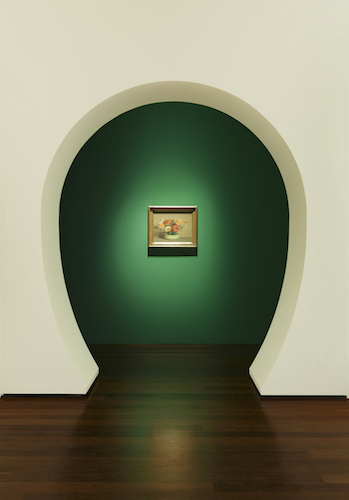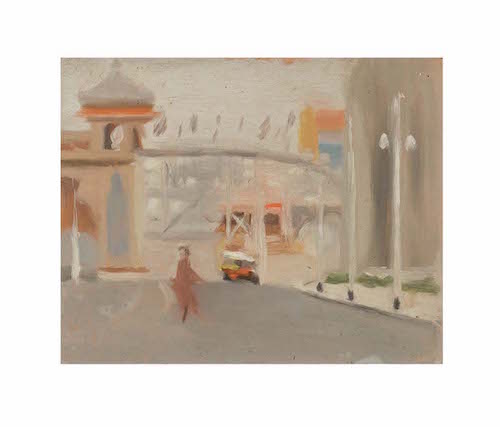Back in the 1920s and 1930s, Melbourne painter Clarice Beckett (1887-1935) enjoyed some small success as an exhibiting artist taking part in both solo and group shows. She painted quickly and freely in the popular tonal realism style, developing a subtle and gentle technique that highlighted soft light, misty mornings, and smudgy shadows.
Like many middle-class women of the time, Beckett was given a suitable art education even though her father seemingly disparaged her creative endeavours. After her death in 1935, aged only 48, her work was largely forgotten, and she was destined to become a mere footnote in the story of Australian art. Some of her peers, such as Roy de Maistre and Elioth Gruner, are now much more widely known and appreciated.
‘Beckett painted quickly and freely in the popular tonal realism style, developing a subtle and gentle technique that highlighted soft light, misty mornings, and smudgy shadows.’
It was in the late 1960s, some 35 years after her death, that Melbourne gallerist Dr Rosalind Hollinrake (then Humphries) happened to meet Beckett’s sister Hilda Mangan. This chance encounter led to the discovery of hundreds of Beckett paintings in an old shed in rural Victoria – a shed which is recreated here in the AGSA exhibition.
The National Gallery was quick to purchase some works in 1971, and AGSA’s then director Ian North added to our collection in 1979. And just last year, philanthropist Alastair Hunter OAM generously gifted a collection of 21 Beckett paintings to AGSA. These works are joined by paintings on loan from other galleries and many private collections, including those of actor Russell Crowe.
Read: Exhibition Review: Overlapping Magisteria: The 2020 Macfarlane Commissions
Curated by Tracey Lock, AGSA’s Curator of Australian Paintings and Sculpture, in association with Dr Hollinrake who attended the launch, this exhibition of 130 paintings is the most comprehensive retrospective of Beckett’s work ever mounted. It clearly showcases her deft touch as a maker of marks and her sensitive feeling for colour and composition. There is a timeless and universal quality to these works, even though many of them are grounded in a specific time and place.

Installation view: Clarice Beckett: The present moment featuring Zinnias (Flower piece) by Clarice Beckett, 1927, Private collection, Art Gallery of South Australia, Adelaide, 2021, photo credit: Saul Steed.
The present moment is hung thematically, inviting the viewer to stroll with Beckett through the misty streets and wind-swept beaches of suburban Melbourne from daybreak to night-time. A few still-life paintings are included, especially flowers, which were a typical subject for painters (especially female painters) of the day. Everlastings, Farewell Summer, and Gladioli, all from 1922/23 are charmingly painterly in their floral depictions.
‘This is an airy hang, allowing the viewer both space and time to appreciate the nuances of each work.’
This is an airy hang, allowing the viewer both space and time to appreciate the nuances of each work. Opening the exhibition, Lock said the paintings show Beckett’s pursuit of her own illusion of reality, something that ultimately all artists strive to do. And there are some nice touches, such as the mirrored cabinet for Sunset showing that it is painted on the back of a 1920s Kellogg’s Corn Flakes box. Other works are painted on pulp board, the most basic of art materials, and yet remain in surprisingly pristine condition.
There is a quietness to the works which is especially appealing to the eye and the psyche. There is nothing grand or attention-seeking here; the paintings whisper their meanings to you, offering a sense of calm and solitude. A little more seating in the galleries would perhaps encourage viewers to pause and indulge in a deeper contemplation of the works on display.

Clarice Beckett, Australia, 1887-1935, Luna Park, 1919, Melbourne, oil on board; Gift of Alastair Hunter OAM and the late Tom Hunter in memory of Elizabeth through the Art Gallery of South Australia Foundation 2019, Art Gallery of South Australia, Adelaide.
Overall, there is a curious uniformity to many of the paintings on display here – regardless of size or subject matter – that perhaps obscures their age and history a little. The physical art objects have their own story to tell, and I feel like some of that may have been lost in the restoration and reframing.
The paintings are accompanied by an original sound-scape by violinist and composer Simone Slattery to contextualise and augment the exhibition. This marriage of music and the visual arts works well with hints of birdsong and the bush, bringing the natural world into the gallery. Musician Gabriella Smart has also composed a piece for the exhibition using the Cristal Baschet, a most unusual instrument comprised of 56 chromatically tuned glass rods. And there is even a Spotify playlist available to go with the exhibition.
‘There is a quietness to the works which is especially appealing to the eye and the psyche.’
Although now generally acknowledged as an important twentieth-century Australian landscape painter, Beckett’s work is still under-valued with many paintings selling at auction over the last decade for remarkably modest prices. Perhaps this expansive and engaging exhibition will help to boost those sales records!
Rating: 5 stars out of 5 ★★★★★
Clarice Beckett: The Present Moment
Curator: Tracey Lock, Curator of Australian Paintings and Sculpture
Art Gallery of South Australia
In association with Adelaide Festival 2021
27 February-16 May 2021
$17/$20






